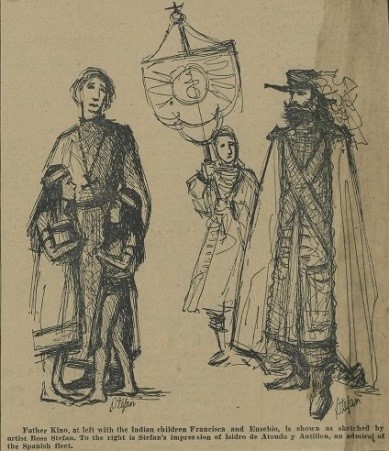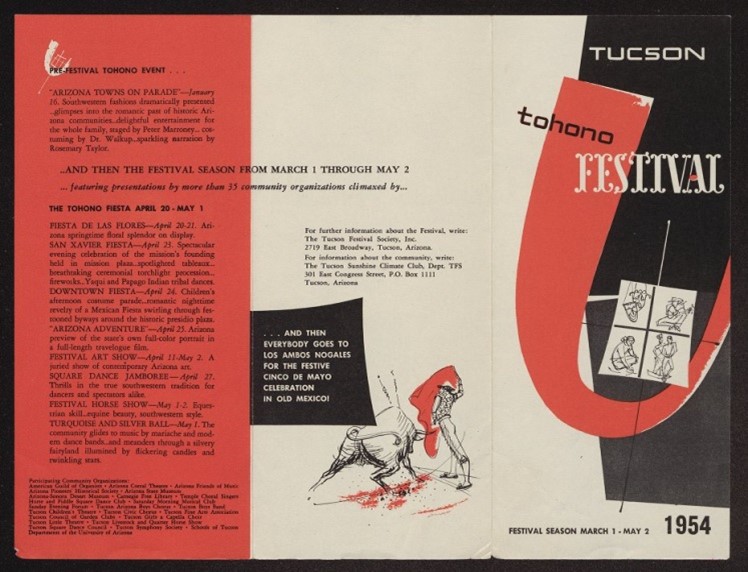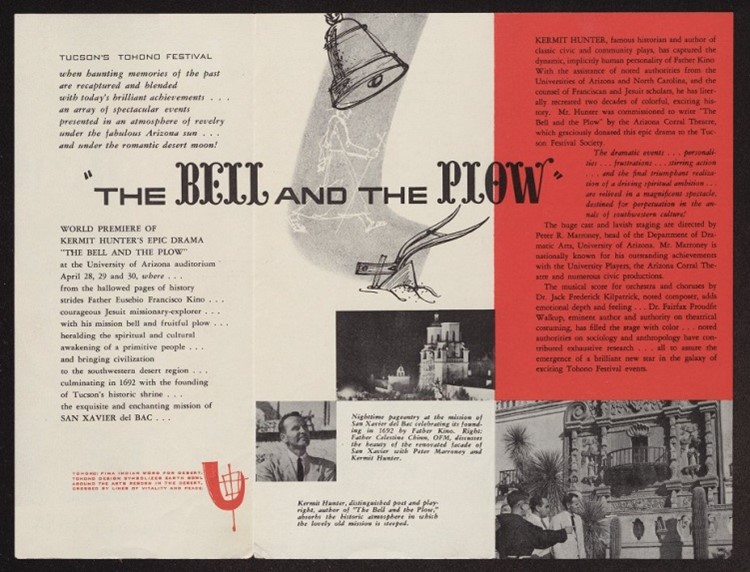"The Bell and The Plow" Kino Play
Playwright Kermit Hunter
Script of The Bell and The Plow and More
To view and download the script of The Bell and The Plow with notes, click on the following two links:
The Bell and The Plow script with notes (pdf)
The Bell and The Plow script with notes (text)
To view and download addition materials, click
"Bell and Plow on Tonight" Tucson Citizen May 28,1954, Front Page
Play Background
"The Bell and The Plow" is a community pageant play about famed Jesuit missionary, scientist & explorer Father Eusebio Francisco Kino (1645-1711) and premiered in the 2,500-seat University of Arizona auditorium in Tucson, Arizona on April 28, 1954 - the 254th anniversary date of the Blue Shell Conference called by Kino in 1700 at Mission San Xavier del Bac. The play by Kermit Hunter was commissioned as part of the 2 month long Tohono Festival sponsored by the Tucson Festival Society. The epic drama genre featured plays about a region's history and were intended to be performed annually. Over 200 people participated in the play as actors, musicians, singers and stage support. Based on 2 newspaper accounts the role of Lascano was played by future Arizona governor Sam Goddard (1965-1967). The intent of the Tucson Festival Society was to stage the Father Kino play annually but due to financial considerations it was only performed in 1954. The music score and choral score was composed by Jack Frederick Fitzpatrick.
Attached to the script above are notes of a costume sketch & the 1954 Tucson Tohono Festival brochure. Also attached are 2 newspaper articles: "Kermit Hunter, Author of 'Unto These Hills' Completes 'Bell and Plow' for Arizona Production" -- The Times-News Henderson, North Carolina October 7, 1953 Page 2; " 'Bell and the Plow' Is Epic Play Deserving Yearly Presentation" -- Tucson Citizen April 29, 1954 Page 2.
"Kermit Hunter, Author of 'Unto These Hills' Completes 'Bell and Plow' for Arizona Production" 1953
Cherokee, October 7. ---- Kermit Hunter, one of the nation's most successful young playwrights, disclosed today the completion of a new play, "The Bell and The Plow," which will be produced next spring at Tucson, Arizona.
This will be the seventh big production to come out of the University of North Carolina. It will be the fourth for Hunter who is author of "Unto These Hills," the nationally acclaimed Cherokee Indian drama presented here annually from late June through early September.
The music for the Arizona production, which has been built, around the life of Father Eusebio Kino, a Jesuit missionary who died in 1711, is being written by Jack Frederick Kilpatrick, the Cherokee Indian composer who did the musical score for "Unto These Hills."
Hunter is revealing his new play and the plans for it, said "The Bell and The Plow" will go into rehearsal at Tucson within the next few weeks and tentatively in scheduled to open in April in the 188-seat [2,500-seat] University of Arizona auditorium.
The project has been undertaken, he said, by the drama department of the University of Arizona and the Corral Theater of Tucson under the director of Peter Marroney. It will be sponsored by the Tucson Festival Association.
Hunter said plans are being made to later erect an outdoor amphitheater near the mission of San Francisco Xavier del Bac outside of Tucson which was built by Father Kino.
Like Hunter's other plays -- "Unto These Hills," "Horn In the West," and "Forever This Land" -- there runs through "the Bell and the Plow" a spiritual theme of the land as a gift of God, the eternal "westwardness" of man, and the idea that religion and progress must go hand in hand.
The title for the new play was taken from the works of Henry David Thoreau. The bell represents the church and plow civilization.
Basically the story is the life and work of Father Kino, an Italian who first went to Spain after schooling in Germany with a vision of going to China, following in the footsteps of his patron saint, St. Francis Xavier.
But instead of going to China, Father Kino was sent to Mexico City and lower California where he tried to establish missions. The missions failed after five years and he came to northern Sonora and built the mission of Dolores. With that as headquarters he established more than 40 missions up and down the desert valleys of Sonora over a period of 25 years.
He explored Southern Arizona and on west to the Colorado River. He made maps of all that region, including lower California. These maps were standard for a hundred years.
He discovered lower California was not an island but a peninsula. He introduced cattle into Southern California and Arizona.
When Hunter talks of his new play and of Father Kino his eyes light up with the fire of a man living a crusade and his words tumble out with a rush.
"Father Kino was a human dynamo," he said. "He rode thousands of mile on horseback, carrying the gospel to the Pima Sobaipuri Indians. He was known as "The Padre on Horseback."
"So the play traces his career. It relates to Tucson by showing as its climax the building of the mission of San Francisco Xavier del Bac."
He said the play will contain Spanish dances, Indian dances, music of the Roman Catholic mass, pastorals, and a wealth of orchestral coloring combined with a huge chorale ensemble of the University of Arizona.
Hunter goes on to suggest that the mysterious hand of God kept Father Kino at this work in Sonora for the purpose of building a great new civilization in the desert country and making possible the further development of Arizona and California.
The author also stresses the brotherhood of man in the idea that a primitive wilderness can be developed into a great civilization by courage, tolerance, determination and Christian understanding.
The script has been check by church officials in Tucson and also by anthropologists of the University of Arizona for authentication and detail.
Hunter said it was his hope and the hope of the sponsoring organizations that the basic fundamentals of the American ideal will be clearly portrayed in the life of Father Kino - "a man who was Arizona's great first cattle baron, planter, builder, craftsman, mapmaker, pioneer and explorer, in the era when the thirteen colonies were little more than scattered settlements upon and down the Atlantic coast."
Headline: Kermit Hunter, Author of 'Unto These Hills' Completes 'Bell and Plow' for Arizona Production
Subhead: New Work in Ninth To Come Out of UNC, Fourth for Hunter
By John Parris
The Times-News Henderson, North Carolina October 7, 1953 Page 2
Web Link
https://news.google.com/newspapers?id=Qn1hAAAAIBAJ&sjid=1yMEAAAAIBAJ&pg=4916%2C4535105
Notes to Attached Script Copies of The Bell and The Plow
Script by Kermit Hunter and Music & Choral Score by Jack Frederick Fitzpatrick
Notes by Mark O'Hare Tucson, Arizona (6 pages) -- July 2, 2016
1. This typed script is copied from the original mimeograph script (third draft). See Item 2 - AHS Library records. Numbers in brackets [ ] reference original numbered pages in the script.
2. Script and score copies are archived in the Arizona Historical Society (AHS) Library (Tucson) in the extensive ephemera files concerning The Tucson Festival Society - Record MS 0921: Box 63-64; Album 15. Record finding aid online at http://www.arizonahistoricalsociety.org/wp-content/upLoads/library_Tucson-Festival-Society.pdf
3. Additional AHS Library contents: review comments to the script made by Dr. Edward Spicer, Rev. Celestine Chinn O.F.M. Two other Spanish colonial historians trained by Herbert Bolton: Dr. Peter Dunne, S.J. and Dr. Russell Ewing reviewed; copies of Fitzpatrick's submitted score and the performance score that was transcribed for additional instruments; notes of the critique meeting by members of the Tucson Festival Society after the performances; publicity & correspondence.
4. U.S. Copyright Office. The Arizona Corral Theater, Inc. is the copyright owner of record. The copyright entry web link is at
https://archive.org/stream/catalogofcopyrig3834libr/catalogofcopyrig3834libr_djvu.txt "ARIZONA CORRAL THEATRE, INC. The Bell and The Plow, a musical play in two acts by Kermit Hunter. [Text only] Appl. Author: Arizona Corral Theatre, Inc., Employer for hire of Kermit Hunter. © Arizona Corral Theatre, Inc.; 12Apr54; DU36677. "
Arizona Corral Theater, Inc. no longer exists. Highly likely that play is in the public domain. No record can be found of Arizona Corral's copyright being renewed.
5. The University of East Carolina Library's 46 online images in its "The Bell and the Plow" scrapbook includes the performance program, newspapers articles, Tucson Festival publicity and records. Link at https://digital.lib.ecu.edu/36522#details. It is part of Outdoor Theater Collection.
6. "The Bell and The Plow" Scrapbook Images from the East Carolina University Library at https://digital.lib.ecu.edu/36522#details

Kino Play Costume Sketch by Artist Ross Stefan
Scenes and Characters
THE BELL AND THE PLOW
WRITTEN BY KERMIT HUNTER
MUSIC BY JACK FREDERICK KILPATRICK
T H I R D D R A F T
TIME: 1680 to 1700
PLACE: Spain, Mexico, Lower California, Arizona
ACT I
Scene 1: Grand Ballroom in the palace of the Duke of Arcos, Madrid, April 12, 1680, about 10:00 in the evening
Scene 2: Kino's quarters in the Jesuit College, Cadiz, one evening a week later
Scene 3: Reception room in Father Pardo's quarters in the Cathedral, Mexico City, early afternoon in the spring of 1682
Scene 4: A hill above the Bay of La Paz, Lower California, spring and summer, 1683
Scene 5: The Mission of San Bruno, Lower California, May 1685
ACT II
Scene 1: The Mission of Dolores, northern Sonora, a late afternoon in January, 1695
Scene 2: Northern Sonora, summer of 1695
Scene 3: The Mission of San Xavier del Bac, southern Arizona, late afternoon April 28, 1770.
The characters and events in this play are based on actual historical records. Certain modifications have been made in the interest of dramatic unity.
CAST OF CHARACTERS
Duchess of Aveiro, Arcos y Macqueda
The Duke, her husband
Father Eusebio Francisco Kino, a Jesuit priest
Father Juan Maria Salvatierra, his friend
Father Antonio Kerschpamer, a member of their company
Carlos de Siguenza y Gongora, professor of mathematics at the Royal University in Mexico City
Father Bernardo Pardo, the Jesuit provincial in Mexico City
The Conde de Paredes, Viceroy of Mexico
Reader of scroll at La Paz, California
Isidro de Atondo y Antillon, an admiral of the Spanish fleet
Father Mathias Goni, companion of Kino in California
Soldier at La Paz
Blas de Guzman, ship captain for the California expedition
Alferes Lascano, another ship captain
Francisca, the Indian girl brought from California by Kino
Pedro, a servant at the Mission of Dolores
Concha, serving woman at Dolores Mission
Conchita, serving woman at Dolores Mission
Father Francisco Xavier de Mora, Kino's superior from Arizpe
Father Horacio Polici, visitor representing the Provincial
Juan Matheo Manje, captain in the Spanish army, alcalde of the district at Dolores
Eusebio, brother of Francisca
Spanish leader at Tupo
Historian
Priests, acolytes, government officials, guests soldiers, Indians

Tucson Festival Society 1954 Tucson Tohono Festival Brochure Page 1
The intent of the Tucson Festival Society was to stage The Bell and The Plough Kino play annually but due to financial considerations it was only performed in 1954. The Tucson Festival Society continued its annual programs and performances celebrating worldwide and Southwestern art and culture until 1996. In 1982 the Society sponsored the beginnings of the Tucson International Mariachi Conference that led to the popularity of the mariachi music tradition throughout the United States.
